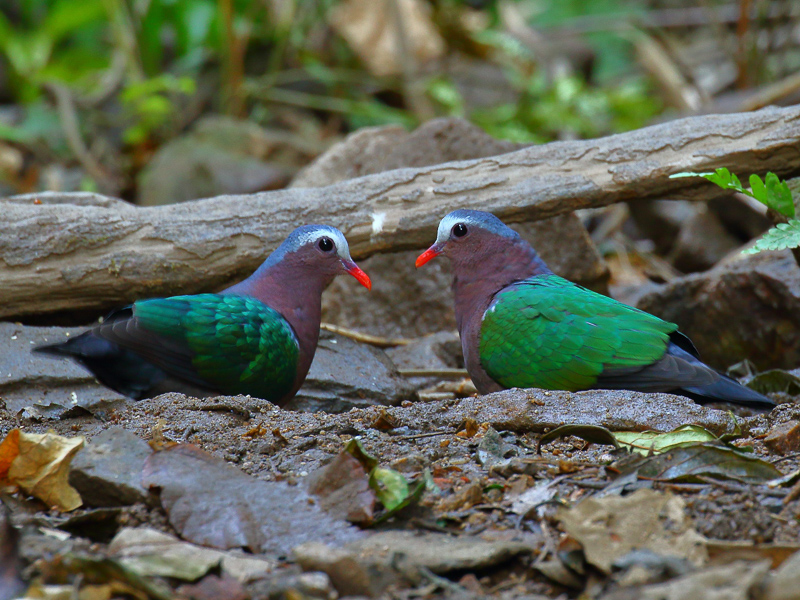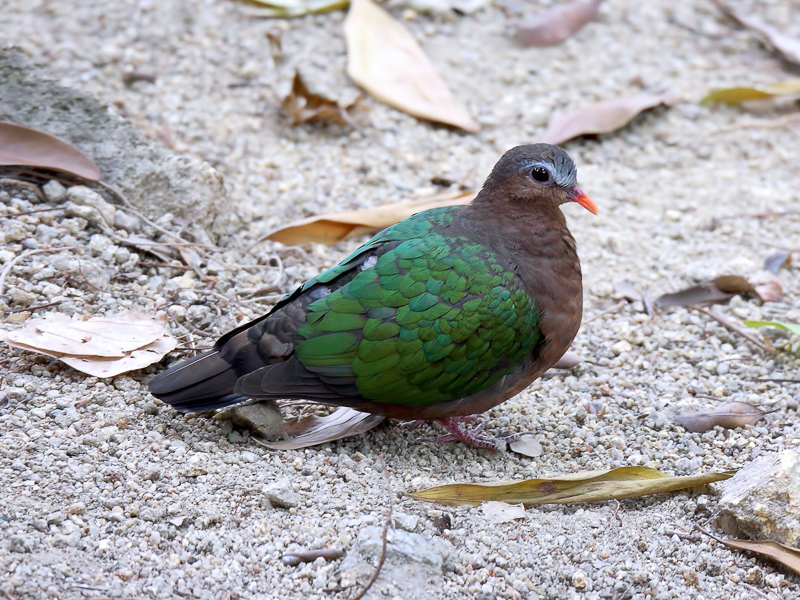Common Emerald Dove Chalcophaps indica 綠翅金鳩
Category I. Scarce but widespread resident in forest and shrubland.
IDENTIFICATION

Jun. 2017, Kenneth Lam. Males.
23-27 cm. Small short-tailed dove with grey crown and nape, dark grey mantle and bright iridescent green scapulars and wing coverts; flight feathers and tail are very dark grey, usually appearing black. Underparts are dark greyish-pink, paler on the belly. Bill is bright red, and tarsi are greyish-red, iris is black. In flight two white bars on the lower back may be conspicuous. Male has obvious silver forecrown.

Feb. 2009, Michelle and Peter Wong. Female.
The female is duller with the silver on the head not extending markedly to forecrown. Juvenile is browner with rufous tips to the greater coverts forming a wing bar.
Whilst unlikely to be confused with any other species if seen well, it is shy, and views are often of flushed birds flying fast and low through the understorey when it often appears all dark. Perhaps more easily detected by its rhythmic deep cooing advertising call (see below).
VOCALISATIONS
The only vocalisation heard is the song, which is a repeated, rhythmic, low-pitched ‘wooop-pup’, the first syllable increasing slightly in pitch and more obviously in volume. There is some variation in the pace of delivery, while differences in the sound itself are often related to distance from the bird and intervening vegetation.
DISTRIBUTION & HABITAT PREFERENCE
Common Emerald Dove is found in most wooded habitats, including mature natural forest, forest edge, plantations, shrubland, fung shui woods and even small wooded groves from sea level to around 900m on Tai Mo Shan. However, the advertising call is most often heard in larger blocks of forest, suggesting that this may be its main breeding habitat. It occurs widely, but sparingly,across HK including most of the islands. Perhaps suprisingly, since it is primarily a forest species, whilst it does occur frequently in the older and more established forest blocks of the central New Territories, there is no concentration there, or indeed elsewhere.
Common Emerald Dove was recorded in 4.2% of 1 km squares in the first (1993-96) and 4.9% in the second (2016-19) breeding atlas surveys and in 2.2% and 2.7% of squares in the first (2001-05) and second (2016-19) winter surveys respectively. Though the lower number of squares in winter may be a consequence of birds being less vocal in midwinter (though they do call frequently in late autumn and early winter), it is also possible that some birds leave HK in winter (see below).
OCCURRENCE
Common Emerald Dove was first recorded in HK on 9 March 1960 when one was seen at the University of Kong Kong. From the 1960s to the mid-1980s there was considerable debate regarding the provenance of birds here, with records first judged to be ex-captive, then as wild birds, and then re-evaluated as likely ex-captive. It was not until Chalmers (1986) that its status as a naturally occurring element of the HK avifauna was finally settled.
The increase in the number of records, commencing in the 1970s and accelerating in the 1980s, was attributed by Carey et al. (2001) in part to natural expansion of the population, but also to the advertising call being much better known by observers. However, it must also have been a consequence of an increase in forest area. As such, it is perhaps surprising that the recent breeding and winter atlas surveys only appeared to indicate a limited further expansion in range since the first atlas surveys.
Common Emerald Dove was generally considered to be resident (e.g., Carey et al. (2001)). However, it is now clear that at least part of the population in HK is migratory and/or dispersive. Regular observations on the island of Po Toi show a seasonal pattern of occurrence there, with birds occurring in spring in April to May and in autumn during September to December. In addition, on Tung Ping Chau there are records from January, April-May and September. Equally, though records at urban migration watch points are few, most have been in the spring and autumn periods. For this low-density resident breeding species, the highest count is related to the distance walked in suitable habitat; this is nine in the south Lamma area on 22 April 2018.
BEHAVIOUR, FORAGING & DIET
Common Emerald Dove is usually seen foraging along forest trails or on the forest floor itself or, perhaps more frequently, in flight as it is flushed by the observer. Most sightings are of single birds or, less often, pairs and it is not seen in parties or flocks. Whilst the peak count recorded in HK is of nine birds, these were recorded in a rather large area of south Lamma on 22 April 2018, not as a single party.
Diet has been little studied in HK. Corlett (1998) found food remnants in three faecal samples, two of which contained undamaged seeds and one invertebrate remains, whilst So (1998) recorded it eating seeds of Macaranga tanarius var. tomentosa.
BREEDING
There appear to be no documented observations of nests in HK. Records of juvenile birds, some clearly very recently fledged, from 25 March to 10 November suggest that the breeding season may be protracted.
RANGE & SYSTEMATICS
The range extends from Nepal and eastern India to the Lesser Sundas (Baptista et al. 2020). In China it is restricted to the southern provinces from Yunnan to Fujian, Zhejiang and Taiwan (Liu and Chen 2021, eBird 2023).
There are six subspecies, with the widespread nominate race found in south China including HK.
CONSERVATION STATUS
IUCN: Least Concern. Population trend decreasing.
Baptista, L. F., P. W. Trail, H. M. Horblit, G. M. Kirwan, E. F. J. Garcia, and P. F. D. Boesman (2020). Asian Emerald Dove (Chalcophaps indica), version 1.0. In Birds of the World (J. del Hoyo, A. Elliott, J. Sargatal, D. A. Christie, and E. de Juana, Editors). Cornell Lab of Ornithology, Ithaca, NY, USA. https://doi.org/10.2173/bow.emedov2.01
Carey, G. J., M. L. Chalmers, D. A. Diskin, P. R. Kennerley, P. J. Leader, M. R. Leven, R. W. Lewthwaite, D. S. Melville, M. Turnbull and L. Young (2001). The Avifauna of Hong Kong. Hong Kong Bird Watching Society, Hong Kong.
Chalmers, M. L. (1986). Annotated Checklist of the Birds of Hong Kong. Hong Kong Bird Watching Society, Hong Kong.
Corlett, R. Y. (1998). Frugivory and seed dispersal by birds in Hong Kong shrubland. Forktail 13: 23-27.
eBird (2023). eBird: An online database of bird distribution and abundance [web application]. eBird, Cornell Lab of Ornithology, Ithaca, New York. Available: http://www.ebird.org. (Accessed: 18 December 2023.).
Liu, Y. and S. H. Chen (eds) (2021). The CNG Field Guide to the Birds of China (in Chinese). Hunan Science and Technology Publication House, Changsha.
So, S. (1998). Fig trees and birds in Hong Kong. MPhil. Dissertation, University of Hong Kong, Hong Kong.

